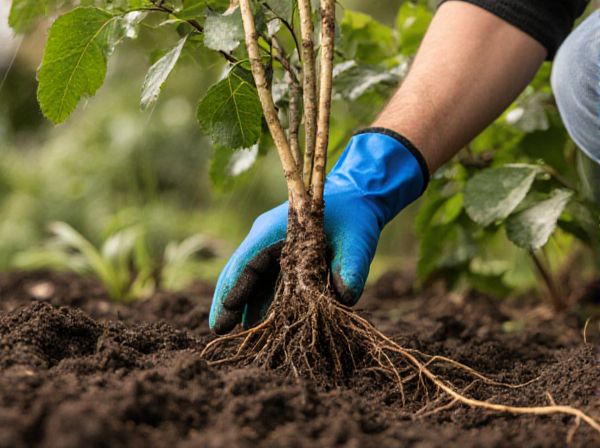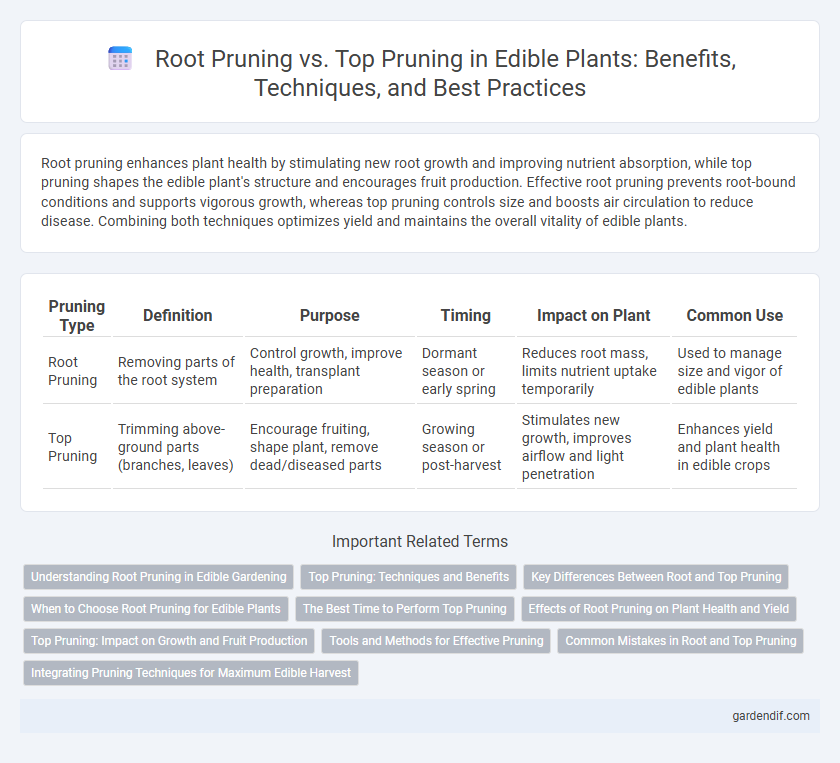
Root Pruning vs Top Pruning Illustration
Root pruning enhances plant health by stimulating new root growth and improving nutrient absorption, while top pruning shapes the edible plant's structure and encourages fruit production. Effective root pruning prevents root-bound conditions and supports vigorous growth, whereas top pruning controls size and boosts air circulation to reduce disease. Combining both techniques optimizes yield and maintains the overall vitality of edible plants.
Table of Comparison
| Pruning Type | Definition | Purpose | Timing | Impact on Plant | Common Use |
|---|---|---|---|---|---|
| Root Pruning | Removing parts of the root system | Control growth, improve health, transplant preparation | Dormant season or early spring | Reduces root mass, limits nutrient uptake temporarily | Used to manage size and vigor of edible plants |
| Top Pruning | Trimming above-ground parts (branches, leaves) | Encourage fruiting, shape plant, remove dead/diseased parts | Growing season or post-harvest | Stimulates new growth, improves airflow and light penetration | Enhances yield and plant health in edible crops |
Understanding Root Pruning in Edible Gardening
Root pruning in edible gardening involves selectively trimming a plant's root system to promote healthier growth and increase fruit or vegetable yield. This technique encourages the development of a more robust root structure, improves nutrient uptake, and prevents root-bound conditions in container-grown plants. Effective root pruning enhances plant vigor and supports sustained productivity in edible crops such as tomatoes, berries, and herbs.
Top Pruning: Techniques and Benefits
Top pruning in edible plants involves trimming the upper portions to enhance light penetration and air circulation, promoting healthier growth and higher yields. Techniques include selective removal of apical buds and strategic thinning of branches to direct energy towards fruit production rather than excessive foliage. This method reduces disease risk and improves fruit quality by allowing better access to sunlight and airflow throughout the canopy.
Key Differences Between Root and Top Pruning
Root pruning involves cutting a plant's roots to control growth and improve nutrient absorption, while top pruning focuses on trimming branches and leaves to shape the plant and enhance fruit or flower production. Root pruning typically affects the plant's overall root system health and stress tolerance, whereas top pruning directly influences canopy density and light penetration. Both techniques require precise timing and methods to avoid damaging the plant and to maximize growth efficiency.
When to Choose Root Pruning for Edible Plants
Root pruning is essential for edible plants when repotting or controlling growth in limited spaces to enhance nutrient absorption and promote healthier roots. This technique is particularly beneficial for fruit trees and container-grown vegetables where root congestion can hinder productivity. Choosing root pruning helps maintain balanced plant development, improving overall yield and plant longevity.
The Best Time to Perform Top Pruning
The best time to perform top pruning on edible plants is during the late winter or early spring, when the plant is still dormant. Pruning at this stage minimizes stress and encourages vigorous new growth when the growing season begins. Avoid top pruning during active growth periods to prevent reduced yield and increased vulnerability to pests and diseases.
Effects of Root Pruning on Plant Health and Yield
Root pruning stimulates a more robust root system by encouraging lateral root development, which improves nutrient and water uptake essential for plant health. This process can enhance overall plant vigor and potentially increase yield by optimizing resource absorption and reducing root overcrowding. However, excessive root pruning may stress the plant, leading to reduced growth and lower productivity if not managed carefully.
Top Pruning: Impact on Growth and Fruit Production
Top pruning enhances light penetration and air circulation within edible plant canopies, promoting healthier growth and reducing disease risk. By selectively removing upper branches, energy allocation shifts toward fruit development, resulting in improved yield and fruit quality. This method also controls plant size, making harvesting easier and increasing overall orchard efficiency.
Tools and Methods for Effective Pruning
Effective root pruning requires sharp, sterilized tools such as pruning saws, spades, or specialized root pruning shears to cleanly cut roots without causing excessive damage. Top pruning utilizes hand pruners, loppers, or pruning saws depending on branch thickness, combined with proper cutting techniques like thinning or heading cuts to promote healthy regrowth. Both methods benefit from sterilization of tools to prevent disease, precise cuts to avoid unnecessary stress, and timing based on plant species' growth cycles for optimal recovery and productivity.
Common Mistakes in Root and Top Pruning
Common mistakes in root pruning include cutting too close to the trunk, which can cause stress and reduce nutrient uptake, and removing excessive roots, leading to poor plant stability. Top pruning errors often involve improper timing or cutting too aggressively, resulting in stunted growth and reduced yield. Avoiding these mistakes ensures healthier edible plants and improved fruit production.
Integrating Pruning Techniques for Maximum Edible Harvest
Combining root pruning and top pruning enhances nutrient allocation and encourages vigorous fruit production, maximizing edible harvests. Root pruning controls root growth to stimulate balanced growth above ground, while top pruning shapes the canopy to improve sunlight penetration and air circulation. Integrating these techniques optimizes plant health and fruit yield, ensuring a higher quality and quantity of edible produce.
Root Pruning vs Top Pruning Infographic

 gardendif.com
gardendif.com